
There was once a Golden Age of Sahara Travel, but Sadly, It’s No More
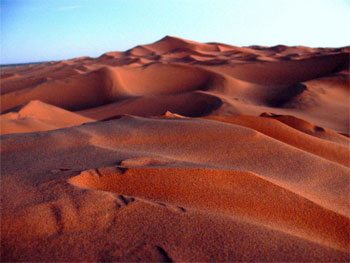
[Editor’s Note: Today, following over a decade of kidnappings, much-increased trafficking, rebellions, revolutions as well as the spread of looted weaponry from Libya, independent tourism in the central Sahara has pretty much collapsed or is severely restricted.
The chances of achieving a true Saharan traverse are currently about as slim as they’ve ever been since the invention of desert driving. Much of the Sahara of Mali, Algeria, Libya, Niger and Egypt are unsafe or off-limits. Eastern Mauritania is said to be the same, and southern Algeria from Bordj towards Djanet is restricted.
But it wasn’t always like that. This story was originally published in 2000 when desert travel was common, ‘the Golden Age of Sahara travel]
Travel in the Sahara back to 2001…Not Possible Today
By Chris Scott
Tomorrow afternoon, your airplane could be touching down at the desert town of Ouarzazate. Having collected your rental four-wheel-drive vehicle, the big decision is to head east, west or south.
Few will be able to resist the temptation to head directly south to the desert along the palm-choked Drâa Valley, or “Valley of a Thousand Kasbahs” as the tourist board likes it to be known.
But the Sahara won’t disappear overnight and by heading east towards Boumaine or west towards Taliouine, you can turn south onto a dirt track and climb into the Atlas mountains that form the last barrier before the Sahara. Passing seasonal snowfields and shepherds, you’ll eventually crest the summit pass. Before you, the vast panorama of the Sahara’s northern fringe unfolds.
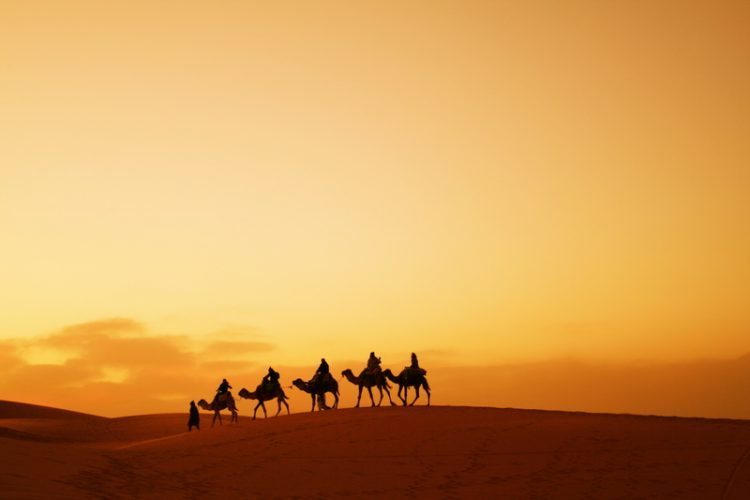
A series of hairpins will drop you 2000 feet to the desert floor, where temperatures rise, the soil becomes sand and vegetation shrivels. Look around and you may spot the distinctive black tents of Berber nomads set back from the track.
To either side, sheltered valleys harbor villages, where subterranean waters feed oases of lush gardens and bountiful orchards of citrus fruit and almonds.
The thin strip of the Moroccan Sahara begins here, between the Anti Atlas and the Algerian border, 40 miles to the south. It’s a truly impressive and accessible slice of the world’s largest desert, and deservedly popular with tourists and travelers.
With a well-prepared vehicle and a sense of adventure, you can explore the fringes of the great desert without committing yourself to a full-blown expedition. With the aid of GPS, off-road route-finding is easy and distances relatively short.
Or you can just take a short tour over the Atlas from the northern Imperial cities for a couple of days of camel trekking in the sands. Go independent or go with a group, but no one leaves southern Morocco disappointed.
*A note about Western Sahara
The Moroccan Sahara also includes the former colony of Spanish Sahara, the vast expanse of the coastal desert now known as Western Sahara. But unlike the Atlas strip, this region of barren rocky plains does not lend itself to casual exploration.
Western Sahara was occupied by Morocco following the death of Franco and the subsequent withdrawal of the Spanish in the 1970s. The indigenous people left behind, now collectively known as the Saharawi, were not keen on Morocco’s annexation and a long guerrilla war led by the Polisario front followed.

Things are relatively quiet now, though Morocco has been busy repopulating the area with native Moroccans to help win the repeatedly postponed United Nations referendum on the future of the Saharawi.
There is still a danger of mines here, and access to the Saharawi capital of Smara may be restricted by Moroccan military. Most travel advisories recommend steering clear of Western Sahara.
However, the bleak interior is bypassed by the coastal highway leading to the Mauritanian border, part of the Atlantic trans-Saharan route to West Africa, and with caution, can be accessed.
If you’re interested in following Saharawi issues, there’s plenty on the web.
ATTRACTIONS
In the Moroccan Sahara, it is not so much a string of highlights to tick off a list, but just being there and wandering. Sure, there are wonderful kasbahs and dunes, oases and villages, but wherever you go, spending a few days driving around and exploring as the fancy takes you is the best way to enjoy the desert.
The region can be divided into the Anti Atlas and the more popular environs of the Drâa Valley and Erg Chebbi dunes to the east.
From the mountains to the desert
A drive through the Anti Atlas offers some of Morocco’s most rewarding vistas and takes you through a quiet but spectacular corner of Morocco barely visited by package tours. Be aware that the towns in this area offer basic amenities much more in tune with the simple lives of the desert dwellers than the four-star palaces found elsewhere.
With a 4 wheel-drive vehicle and a good route guide, you can traverse the entire width of the Moroccan Sahara from the Atlantic coast south of Agadir to the dunes of Erg Chebbi 700 miles inland.
Tata is a sleepy desert town with colonnaded streets where the mountains meet the desert. A memorable way of reaching Tata is from the mountain town of Igherm in the northwest. You can take the minor road, but with a 4-wheel drive vehicle, the tantalizing cross-country option is the 60-mile piste (unpaved track) that tips off the high plateau in a series of hairpins to suddenly arrive at the beautiful desert oasis of Tleta Tagout.
South of the village, but set back from the track, you’ll spy Berber encampments and pass the fabulously twisted rock formations exposed by millennia of weathering. Other pistes drop from the ranges into the desert in a no less dramatic fashion, such as the 160 mile-route from Taliouine to Foum Zguid, a gateway or ‘mouth’ in the Jebel Bani range that opens out onto the desert.
Zagora and the Drâa Valley
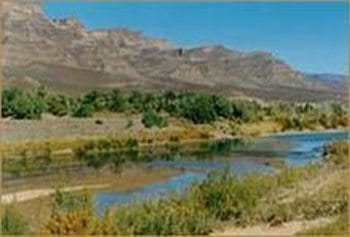
The mountain town of Ouarzazate is a departure point for the famous kasbah of Aït Benhaddou, an elaborately decorated ochre-walled citadel attracting nesting storks and inspiring Hollywood film directors. To the south is the Drâa Valley (see Slowing It Down in the Drâa), choked with palm plantations and with still more of Morocco’s evocative kasbahs in various states of repair.
East of Ouarzazate rise the basalt ramparts of Jebel Sarhro, a popular trekking region and close to the famous gorges of Dades and Todra near the town of Tinerhir. The gorges are impressive, narrowing in places to a house-wide chasm and popular with rock climbers, but they’re thronged with coach tours and the associated hassle.
Having paid your respects you can escape south along a track that winds up to the summit pass of Jebel Sarhro, where from 7000 feet you can look over the brutal volcanic moonscape to the tawny desert plain beyond.
Situated in the midst of the Drâa Valley, Zagora is a likeable desert resort town, full of flat-roofed hotels with uninterrupted desert views and souvenir shops selling carpets and brass trinkets; it’s a popular starting point for camel excursions or ‘sleep outs’ in Berber tents, all easily arranged locally for under $20. (see Slowing It Down in the Drâa)
While you’re in town, be sure to check out the weekly souk (market) where you can stock up on dates and sheep’s eyes and haggle over buckets made out of old tires. South of Zagora the ancient Koranic library at Tamagroute lies close to the alluring dunes of Tinfou a short distance from the highway.
The dunes of Erg Chebbi
East of the Drâa Valley, the Erg Chebbi sand sea is quintessential Saharan romance, a 20-mile stretch of undulating waves of golden sand, formed into sensual curved ridges. Just about every tour includes a night at one of the auberges (basic lodges) on the Erg’s western flank, and sunset walk or camel ride into the dunes. But don’t be discouraged by Erg Chebbi’s mainstream popularity–the exhilaration of wandering barefoot through the dunes is a highlight of the Moroccan Sahara. (See Cell Phones in the Sahara)
If you’re an experienced off-road driver, you can continue from the nearby village of Merzouga, deep into the desert along a fabulous 160-mile piste through an authentic Saharan landscape of sand plains and distant ridges. It ends a day or two later at Tagounite back in the Drâa Valley.
TOURING
Though touring the Moroccan Sahara is easy to do independently, several U.S. and U.K.-based tour operators offer Moroccan tours, which often include desert safaris ranging from an overnight to a few days. IN 2018, VERY FEW TRAVELERS ARE GOING HERE DUE TO THE KIDNAPPING AND SAFETY PROBLEMS. WE DO NOT RECOMMEND GOING HERE.
The typical route starts in Marrakech and crosses the High Atlas to Ouarzazate. From here it heads down the Drâa Valley to Zagora and the dunes at Tinfou, and takes a desert track towards Erfoud and Erg Chebbi. It then heads back via the Todra and Dades gorges before returning over the Atlas to Marrakech. In the end, you’ll have experienced the definitive Moroccan Sahara as well as the beautiful kasbahs of the High Atlas and a day’s shopping in Marrakech.
You can easily arrange your own camel treks from an hour to a week out of the Drâa Valley or into the Erg Chebbi dunes in Merzouga or Zagora. Most hotels offer inexpensive treks that can be arranged when you arrive. It’s also possible to arrange camel treks when you reach villages such as M’hamid on the edge of the desert. Longer camel excursions are not so satisfying because of the predominantly stony terrain.

Local Outfitters for Camel Treks
LaFibule du Drâa
Zagora
212-4-84-73-18
Fax 212-4-84-72-71
fibule@atlasnet.net.ma
Organizes camel rides and excursions, including overnights in M’hamid.
Auberge-Répos Sable Tinfou
Tamegroute
212-4-84-85-66
Will also organize camel trips to the nearby Tinfou dunes.
Auberge La Caravanne
near Merzouga
Offers treks in the dunes of Erg Chebbi, camping, a hotel and a restaurant. Treks can range from overnight to a week or longer. Full moon treks are popular, for good reason.
LODGINGS
Morocco has a huge range of hotels catering for all budgets. In the dirty, noisy but intriguing medinas of the old cities you’ll find single rooms from $3, with just a bed and a light bulb, shared washrooms and the call-to-prayer chant of the muezzin in your ear at 5 a.m.
Beyond the walls in the new towns built during the French colonial era, you can be sure that anything over $60 will give you a clean, modern en suite room with air-con and little to complain about.
In the Sahara, your choices narrow away from the tourist towns like Erfoud and Zagora. Hotels will be basic kasbah-style joints, at best offering full Moroccan hospitality. You’ll also come across auberges, or campements–basic mud-brick or grass-hut guesthouses with shared facilities.
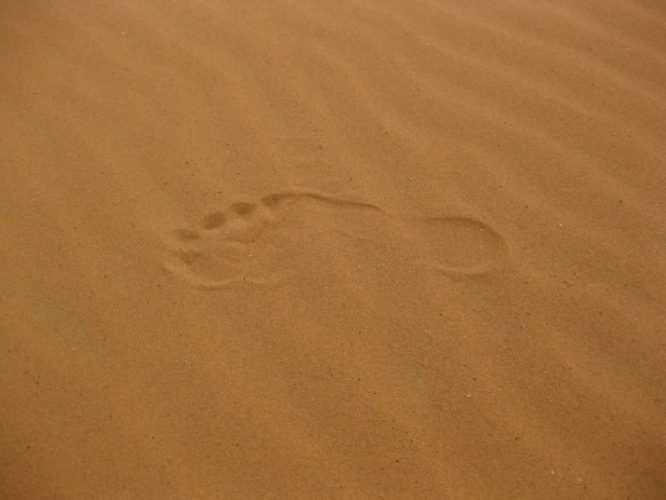
Hotel Sahara
M’hamid
The last town in the Drâa valley before it runs into the desert. Basic rooms at $8 a double but a comfortable dining area. Can organize camel treks into the nearby dunes. The Hotel Iriqui opposite is just as good value.
Hotel de la Palmerie
Zagora
Modern hotel with a pool and very good value at $16 a double. Right by the famous “52 days to Timbuktu” sign at the south end of town. Erg Chebbi
Along the west bank of the Erg Chebbi north of Merzouga are several auberges or lodges situated right by the dunes. Ranging from inexpensive sleep-on-the-roof places to deluxe tents, most offer inexpensive camel treks.
Halfway between Erfoud and Merzouga, the Yasmina has basic rooms from just $6 and makes delicious tagines, Moroccan stews.
Fort Bou Jerif is signposted west of Guelmim, north of Tan Tan on the Atlantic Highway. Built in the style of a Foreign Legion fort (the ruins of the original are a mile away), rooms are relatively expensive at $40 but, being run by a French couple, the food is excellent and there is always the option of sharing a Berber tent (or camping with your own vehicle). Four wheel drive tours are offered to the nearby Plage Blanche (White Beach).
EATS
Food is inexpensive, varied and plentiful in Morocco. From fresh fruits to tasty grilled meats and stews, you can eat well for very little. Hotel restaurants are often your only choices in the Sahara, but there’s nothing like a meal cooked under the stars in a desert oasis.
The Moroccan dish of choice is tagine, a stew slow-cooked over charcoal in an earthenware dish with a distinctive conical lid. Spiced to varying degrees, there are several versions: lamb with almonds, chicken with olives or sometimes fish with vegetables. You may also get kefta–meatballs–cooked tagine-style.
Couscous is the famous Moroccan dish: steamed semolina with chunks of mutton and carrot served from one huge dish. Compared to a tasty tagine, it’s overrated. Either of these meals may be preceded by a spicy (sometimes exceedingly spicy) and filling, bean-based harira soup which can be mopped up with French-style baguettes and accompanied by the ubiquitous salade marocain, basically tomatoes, cucumbers and lettuce.
Your meal done, a glass of mint tea is a refreshing way to aid digestion. Served with huge quantities of sugar, it can be sickly or bitter at first, with the taste improving with subsequent brews.
SHOPPING
Morocco offers a mouth-watering array of souvenirs in the souks and at roadside stalls. Take your pick from a vast range of colorful ceramics, brass trays, and metal teapots, vibrant spices and pigments, fossils and leatherware.
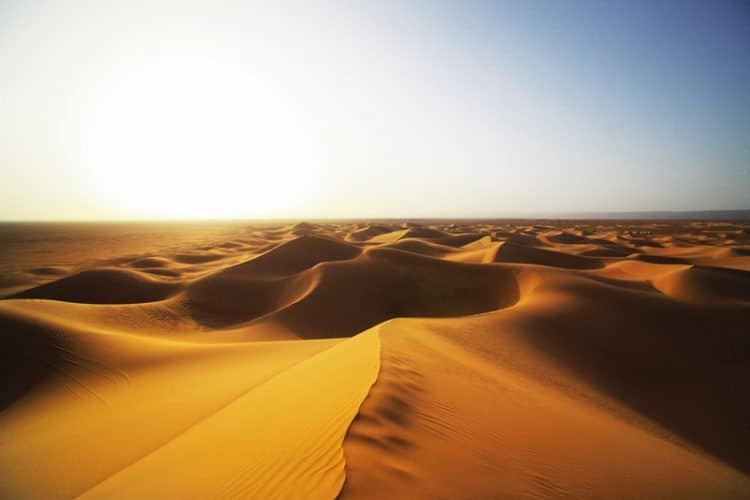
Carpets are a specialty and many are gorgeous, though you’ll be spun any number or yarns about the ancestral origins of an old bath mat. A practiced scam sees the innocent led into a carpet shop, plied with tea and generally softened up to buy something they may not want. Never name or agree to a price that you are not prepared to pay, take your time (days, if possible), and bargain good-naturedly. Take your carpet away with you if you can, as the “all-inclusive” postal service offered might not yield the quality items you actually purchased.
In the desert towns, craftsmen and roadside stalls sell silver jewelry, rose water, dates, textiles and other local specialties. While the selection is not as overwhelming as in the souks of Marrakech or Fes, the prices are much lower and the haggling is much more laid back. Beware, however, of the fake fossils and gems, they are often nothing more than painted glass or plaster replicas.
HAPPENINGS
Moussems might be described as Thanksgiving celebrations that occur year-round all over rural Morocco. Precise dates are difficult to give; they can be either a full-on harvest festival with song and dance or just a bigger-than-average weekly souk.
One of the best known is the Engagement Festival in Imilchil in the High Atlas. Some tours coincide with this Fall event. Erfoud’s Date Festival occurs in October/November and in February Tafraoute region has its almond blossom moussem. Other moussems celebrate cotton, roses, clementines and other fruits.
WEATHER
Autumn and spring are the most comfortable seasons in the Moroccan Sahara, with winter nights freezing at altitude, and summer days in the desert easily exceeding 100 degrees F. It’s important to distinguish between the agreeable summer trekking season in the High Atlas, which is certainly not the trekking or anything else season in the Sahara, just a short distance to the south. Be aware that the passes over the High Atlas are 3000 feet higher than the desert and can be blocked by snow as late as March, while floods can occur at any time.
GETTING THERE
Planes
There are direct flights from Toronto, Montreal, and New York to Casablanca with Royal Air Maroc from US$ 600 in the low season (September-March), the best time to explore the desert. From Casa (as it’s known) it’s possible to connect to airports a little closer to the desert, such as Agadir or Ouarzazate, making it cheaper if you’re renting a car.
Access International occasionally operates charter flights from New York, but these only turn up in the summer.
Flying to Morocco via Europe opens up several more options. Air France, British Airways, Iberia, and KLM all link North America and Agadir (the best jumping-off point for car rental and the Sahara) via their respective European airports. Fares work out at around $800 in the low season.
Boats
Ferries leave from Spain via Gibraltar and Marseille, arriving in Tangiers. It’s a raucous trip, and Tangiers port leaves a lot to be desired, but if you’re coming from Europe, it’s the cheapest way to get to Morocco. Check schedules for exact times.
GETTING AROUND
Public transport is fine and there are many buses from major cities to desert towns but don’t think you’ll see more than a tantalizing view of the Sahara through a dirty bus window or a short walk beyond the edge of town. The essence of the desert is found far from the settlements and paved roads.
The best way to appreciate the fringes of the Sahara is in a rented car, or better still, rent a four wheel drive vehicle that allows you to get off the paved roads and into the desert with confidence.
Unlike other Saharan countries, rental cars are easily available from city airports, allowing you to explore the region on highways, or, if you wish, on a network of rough but easy-to-follow desert tracks where a 4×4 or dual sport motorcycle will be best.
Remember, it’s not as simple as slinging your suitcases into the back of a jeep and roaring off into the dunes. If you’re serious about getting on the dirt (and there is no reason why it can’t be done), a book like Sahara Overland lists over 1100 kilometers of GPS-ed routes in the Moroccan Sahara, as well as detailed guidance on the equipment and recovery techniques. (Also see Driving the Sahara)
At the very least, check that your rental vehicle has a spare tire and the tools to change it. Also, buy yourself an inexpensive 20-liter gas can from the local market and fill it with emergency fuel and bring along plus a box of bottled water
The coastal resort of Agadir is the most convenient place to rent a car for the Sahara, with Hertz, Budget, Avis and Europcar branches. You can also rent at the Agadir and Ouarzazate airports.
Local agencies based at the airport will offer even better rates. Few are on the web, so check out recommendations in the travel guides listed below.
Car rental prices start at $300 a week for a compact, tolerable for a couple on a budget and sticking to sealed roads. A better bet would be a Toyota RAV4 for around $800/week; comfortable for two and with adequate ground clearance and four-wheel drive for the pistes and tracks. If you want to do the Sahara in style, something like a Mitsubishi Pajero or a Toyota Land Cruiser will cost $1200/week but will seat a family and their gear in comfort.
Always opt for unlimited mileage deals as you could easily cover 2000 kilometers in a week’s exploring. Fuel in Morocco works out at US 80c/liter for gas and US 50c/liter for diesel.
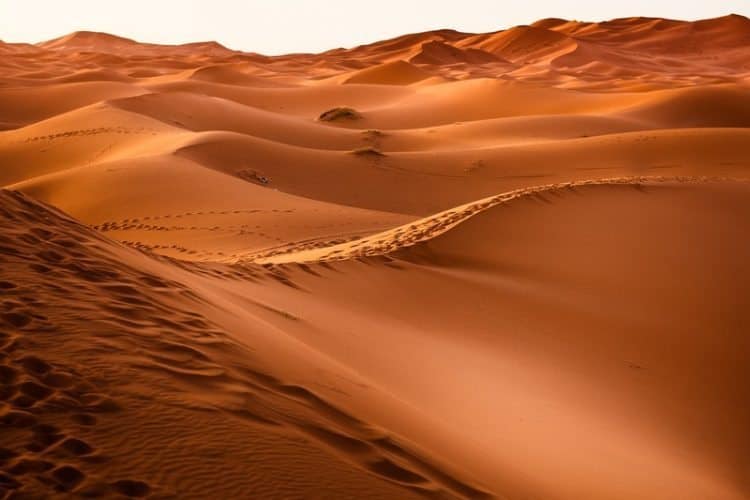
*A note on driving in the desert
Ironically, more tourists come to grief in the Moroccan desert than in “real” Saharan countries, mainly because drivers in Morocco are more casual about the desert than those who venture deeper into the Sahara.
However minimal you expect your brush with the desert to be–even if it’s simply an hour’s foray on sandy tracks–it is essential to always carry sufficient quantities of water and to know the basic procedures for getting a vehicle unbogged from sand.
Many tourists venture off the sealed roads in an ordinary rental car, but this is courting trouble. The problems start when the car gets bogged or wrecks its undercarriage; the driver then tries to walk back for help, gets dehydrated and lost, and collapses within a few miles. See Driving the Sahara for more detailed information on desert driving and safety.
VISAS AND OTHER OFFICIAL THINGS
No visas are required for North Americans or Europeans for a stay of up to 90 days. Airport immigration is straightforward.
MONEY
The current exchange rate is approximately 10 dirhams to a U.S. dollar, and exchange is available in banks and bureaus de change in main towns. If you’re heading for the desert, carry enough dirhams to get you through, as small towns may not have any money-changing facilities. ATMs are found in the main cities. There is no black market. In the big cities and especially near ATMs, be wary of snatch-and-grab thieves.
HEALTH AND SAFETY
Morocco is one of the safest North African countries. In fact, aside from hustlers and touts in the big cities, (which have been brought more or less under control by the new Tourist Police), the country is safer than most cities in the U.S. or Europe. Islamic fundamentalism is kept at a distance (the border to Algeria is sealed for this reason), and the hospitality of urban Moroccans and Saharan villagers can’t be beaten.
As far as health goes, the worst you can expect in Morocco is a dose of diarrhea from poorly prepared food. Carry medications like Imodium, so your holiday won’t be disrupted. Bottled water is widely available and advisable for the same reasons. Though emergency medical facilities are available in the big cities, many doctors do not speak English and most clinics and hospitals will require payment at the time of service. Travelers should carry a personal medical kit and travel insurance is advisable.
No immunizations are required for travel to Morocco from North America, however, if you plan to travel from other locations in sub-Saharan Africa, you will need a Yellow Fever vaccine.
Advisory: Well away from the Sahara and worth avoiding is the cannabis-growing region of the Rif mountains in the northeast, including the hash-manufacturing center of Ketama. While the government is ambivalent about its own people using cannabis, tourists who get caught will be nailed to the floorboards to show the international community Morocco means business. The risk is just not worth it. But if you do score, do not try to take hashish out of the country. Bad news.
US State Dept Travel Information: Morocco
COMMUNICATIONS
After Arabic and various Berber dialects, the most useful language in Morocco is French, with some English spoken in tourist areas. The postal service and telephones are all reliable and cybercafés are cropping up in all big cities and tourist towns. It is useful to purchase a Moroccan phone card, however, as public phones do not accept coins. Public phone cards can be purchased at kiosks in major cities.
RESOURCES
For detailed information on the Sahara and on driving routes
sahara-overland.com
Morocco Guide
tourism-in-morocco.com
A wide variety of information on Morocco
morocco.com
Moroccan National Tourist Office in New York
(212) 557-2520
- Valentine’s Day Suggestions…for that Special Person - January 22, 2026
- Missouri Sports Travel Adventure: From Landmarks to Ballparks - January 21, 2026
- What First-Time Visitors Get Wrong About Visiting Iceland - January 15, 2026







